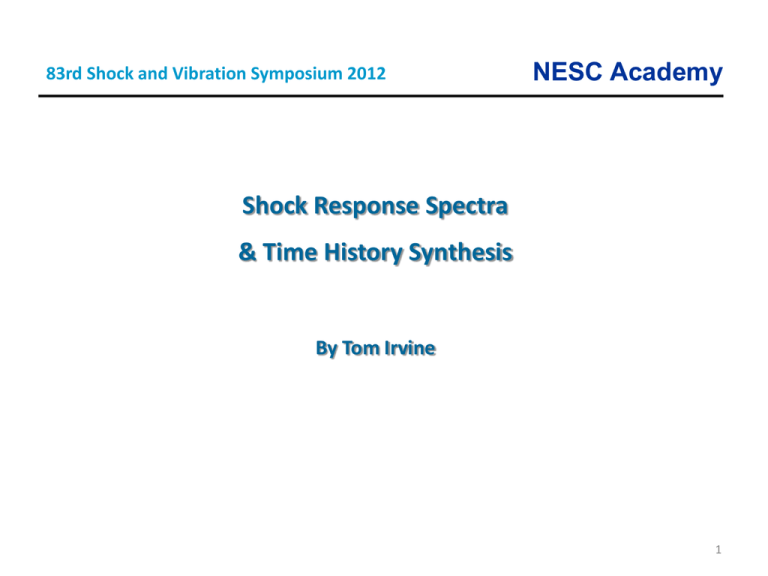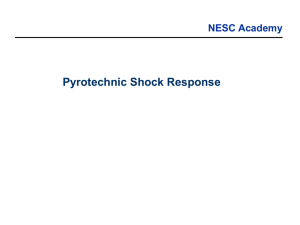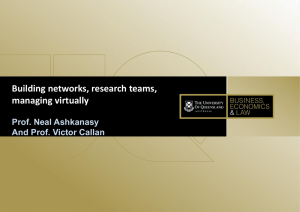NESC Academy - Vibrationdata
advertisement

83rd Shock and Vibration Symposium 2012 NESC Academy Shock Response Spectra & Time History Synthesis By Tom Irvine 1 This presentation is sponsored by NASA Engineering & Safety Center (NESC) Dynamic Concepts, Inc. Huntsville, Alabama 2 Contact Information Tom Irvine Email: tirvine@dynamic-concepts.com Phone: (256) 922-9888 The software programs for this tutorial session are available at: http://www.vibrationdata.com Username: lunar Password: module 3 NESC Academy Response to Classical Pulse Excitation Outline 1. Response to Classical Pulse Excitation 2. Response to Seismic Excitation 3. Pyrotechnic Shock Response 4. Wavelet Synthesis 5. Damped Sine Synthesis 6. MDOF Modal Transient Analysis NESC Academy Classical Pulse Introduction NESC Academy Vehicles, packages, avionics components and other systems may be subjected to base input shock pulses in the field The components must be designed and tested accordingly This units covers classical pulses which include: Half-sine Sawtooth Rectangular etc 6 Shock Test Machine NESC Academy Classical pulse shock testing has traditionally been performed on a drop tower The component is mounted on a platform which is raised to a certain height The platform is then released and travels downward to the base The base has pneumatic pistons to control the impact of the platform against the base In addition, the platform and base both have cushions for the model shown platform base The pulse type, amplitude, and duration are determined by the initial height, cushions, and the pressure in the pistons 7 Half-sine Base Input NESC Academy 1 G, 1 sec HALF-SINE PULSE Accel (G) Time (sec) 8 Systems at Rest Soft Hard Natural Frequencies (Hz): 0.063 0.125 0.25 0.50 Each system has an amplification factor of Q=10 1.0 2.0 4.0 9 Click to begin animation. Then wait. 10 Systems at Rest Soft Hard Natural Frequencies (Hz): 0.063 0.125 0.25 0.50 1.0 2.0 4.0 11 Responses at Peak Base Input Soft Soft system has high spring relative deflection, but its mass remains nearly stationary Hard Hard system has low spring relative deflection, and its mass tracks the input with near unity gain 12 Responses Near End of Base Input Soft Hard Middle system has high deflection for both mass and spring 13 Soft Mounted Systems NESC Academy Soft System Examples: Automobiles isolated via shock absorbers Avionics components mounted via isolators It is usually a good idea to mount systems via soft springs. But the springs must be able to withstand the relative displacement without bottoming-out. 14 Isolated avionics component, SCUD-B missile. Public display in Huntsville, Alabama, May 15, 2010 Isolator Bushing 15 But some systems must be hardmounted. Consider a C-band transponder or telemetry transmitter that generates heat. It may be hardmounted to a metallic bulkhead which acts as a heat sink. Other components must be hardmounted in order to maintain optical or mechanical alignment. Some components like hard drives have servo-control systems. Hardmounting may be necessary for proper operation. 16 SDOF System NESC Academy 17 Free Body Diagram NESC Academy Summation of forces 18 Derivation NESC Academy Equation of motion Let z = x - y. The variable z is thus the relative displacement. Substituting the relative displacement yields Dividing through by mass yields 19 19 Derivation (cont.) NESC Academy By convention is the natural frequency (rad/sec) is the damping ratio 20 Base Excitation NESC Academy Half-sine Pulse Equation of Motion Solve using Laplace transforms. 21 SDOF Example NESC Academy A spring-mass system is subjected to: 10 G, 0.010 sec, half-sine base input The natural frequency is an independent variable The amplification factor is Q=10 Will the peak response be > 10 G, = 10 G, or < 10 G ? Will the peak response occur during the input pulse or afterward? Calculate the time history response for natural frequencies = 10, 80, 500 Hz 22 SDOF Response to Half-Sine Base Input NESC Academy >> halfsine halfsine.m version 1.4 December 20, 2008 By Tom Irvine Email: tomirvine@aol.com This program calculates the response of a single-degree-of-freedom system subjected to a half-sine base input shock. Select analysis 1=time history response 2=SRS 1 Enter the amplitude (G) 10 Enter the duration (seconds) 0.010 Enter the natural frequency (Hz) 10 Enter amplification factor Q 10 maximum acceleration = minimum acceleration = 3.69 G -3.154 G Plot the acceleration response time history ? 1=yes 2= no 1 23 maximum acceleration = minimum acceleration = 3.69 G -3.15 G 24 maximum acceleration = minimum acceleration = 16.51 G -13.18 G 25 maximum acceleration = minimum acceleration = 10.43 G -1.129 G 26 Summary of Three Cases NESC Academy A spring-mass system is subjected to: 10 G, 0.010 sec, half-sine base input Shock Response Spectrum Q=10 Natural Frequency (Hz) Peak Positive Accel (G) Peak Negative Accel (G) 10 3.69 3.15 80 16.5 13.2 500 10.4 1.1 Note that the Peak Negative is in terms of absolute value. 27 Half-Sine Pulse SRS NESC Academy >> halfsine halfsine.m version 1.5 March 2, 2011 By Tom Irvine Email: tomirvine@aol.com This program calculates the response of a single-degree-of-freedom system subjected to a half-sine base input shock. Assume zero initial displacement and zero initial velocity. Select analysis 1=time history response 2=SRS 2 Enter the amplitude (G) 10 Enter the duration (seconds) 0.010 Enter the starting frequency (Hz) 10 Enter amplification factor Q 10 Plot SRS ? 1=yes 2= no 1 28 SRS Q=10 10 G, 0.01 sec Half-sine Base Input X: 80 Hz Y: 16.51 G Natural Frequency (Hz) 29 Program Summary NESC Academy Matlab Scripts Papers halfsine.m sbase.pdf terminal_sawtooth.m terminal_sawtooth.pdf unit_step.pdf Video HS_SRS.avi 30 NESC Academy Response to Seismic Excitation El Centro, Imperial Valley, Earthquake NESC Academy Nine people were killed by the May 1940 Imperial Valley earthquake. At Imperial, 80 percent of the buildings were damaged to some degree. In the business district of Brawley, all structures were damaged, and about 50 percent had to be condemned. The shock caused 40 miles of surface faulting on the Imperial Fault, part of the San Andreas system in southern California. Total damage has been estimated at about $6 million. The magnitude was 7.1. El Centro Time History NESC Academy EL CENTRO EARTHQUAKE NORTH-SOUTH COMPONENT 0.4 0.3 0.2 ACCEL (G) 0.1 0 -0.1 -0.2 -0.3 -0.4 0 10 20 30 TIME (SEC) 40 50 Algorithm NESC Academy Problems with arbitrary base excitation are solved using a convolution integral. The convolution integral is represented by a digital recursive filtering relationship for numerical efficiency. Smallwood Digital Recursive Filtering Relationship x i NESC Academy 2 exp n t cosd t x i 1 exp 2 n t x i 2 1 exp n T sin d T y i 1 d T 1 sin d T y i 1 2 exp n T cosd T d T 1 exp n T sin d T y i 2 exp 2 n T d T El Centro Earthquake Exercise I Run Matlab script: arbit.m Acceleration unit : G ASCII text file: elcentro_NS.dat Natural Frequency (Hz): 1.8 Q=10 Include Residual? No Plot: maximax NESC Academy El Centro Earthquake Exercise I Peak Accel = 0.92 G NESC Academy El Centro Earthquake Exercise I Peak Rel Disp = 2.8 in NESC Academy El Centro Earthquake Exercise II Run Matlab script: srs_tripartite Acceleration unit : G ASCII text file: elcentro_NS.dat Starting frequency (Hz): 0.1 Q=10 Include Residual? No Plot: maximax NESC Academy SRS Q=10 El Centro NS NESC Academy fn = 1.8 Hz Accel = 0.92 G Vel = 31 in/sec Rel Disp = 2.8 in Peak Level Conversion NESC Academy omegan = 2 fn Peak Acceleration ( Peak Rel Disp )( omegan^2) Pseudo Velocity ( Peak Rel Disp )( omegan) Run Matlab script: srs_rel_disp Input : 0.92 G at 1.8 Hz Golden Gate Bridge NESC Academy Note that current Caltrans standards require bridges to withstand an equivalent static earthquake force (EQ) of 2.0 G. May be based on El Centro SRS peak Accel + 6 dB. Program Summary NESC Academy Matlab Scripts arbit.m srs.m srs_tripartite.m 43 NESC Academy Pyrotechnic Shock Response Delta IV Heavy Launch NESC Academy The following video shows a Delta IV Heavy launch, with attention given to pyrotechnic events. Click on the box on the next slide. 45 Delta IV Heavy Launch (click on box) NESC Academy 46 Pyrotechnic Events NESC Academy Avionics components must be designed and tested to withstand pyrotechnic shock from: Separation Events • Strap-on Boosters • Stage separation • Fairing Separation • Payload Separation Ignition Events • Solid Motor • Liquid Engine 47 Frangible Joint NESC Academy The key components of a Frangible Joint: ♦ Mild Detonating Fuse (MDF) ♦ Explosive confinement tub ♦ Separable structural element ♦ Initiation manifolds ♦ Attachment hardware 48 Sample SRS Specification NESC Academy Frangible Joint, 26.25 grain/ft, Source Shock SRS Q=10 fn (Hz) Peak (G) 100 100 4200 16,000 10,000 16,000 49 dboct.exe NESC Academy Interpolate the specification at 600 Hz. The acceleration result will be used in a later exercise. 50 51 Pyrotechnic Shock Failures NESC Academy Crystal oscillators can shatter. Large components such as DC-DC converters can detached from circuit boards. 52 Flight Accelerometer Data, Re-entry Vehicle Separation Event Source: Linear Shaped Charge. Measurement location was near-field. NESC Academy Pyrotechnic Shock Exercise Run script: srs.m External ASCII file: rv_separation.dat Starting Frequency: 10 Hz Q=10 NESC Academy Flight Accelerometer Data SRS Absolute Peak is NESC Academy 20385 G at 2420 Hz Flight Accelerometer Data SRS (cont) Absolute Peak is 526 in/sec at NESC Academy 2420 Hz Historical Velocity Severity Threshold NESC Academy For electronic equipment . . . An empirical rule-of-thumb in MIL-STD-810E states that a shock response spectrum is considered severe only if one of its components exceeds the level Threshold = [ 0.8 (G/Hz) * Natural Frequency (Hz) ] For example, the severity threshold at 100 Hz would be 80 G. This rule is effectively a velocity criterion. MIL-STD-810E states that it is based on unpublished observations that military-quality equipment does not tend to exhibit shock failures below a shock response spectrum velocity of 100 inches/sec (254 cm/sec). The above equation actually corresponds to 50 inches/sec. It thus has a built-in 6 dB margin of conservatism. Note that this rule was not included in MIL-STD-810F or G, however. NESC Academy Wavelet Synthesis Shaker Shock NESC Academy A shock test may be performed on a shaker if the shaker’s frequency and amplitude capabilities are sufficient. A time history must be synthesized to meet the SRS specification. Typically damped sines or wavelets. The net velocity and net displacement must be zero. 59 Wavelets & Damped Sines NESC Academy ♦ A series of wavelets can be synthesized to satisfy an SRS specification for shaker shock ♦ Wavelets have zero net displacement and zero net velocity ♦ Damped sines require compensation pulse ♦ Assume control computer accepts ASCII text time history file for shock test in following examples 60 Wavelet Equation NESC Academy Wm (t) = acceleration at time t for wavelet m Am = acceleration amplitude f m = frequency t dm = delay Nm = number of half-sines, odd integer > 3 61 Typical Wavelet NESC Academy WAVELET 1 FREQ = 74.6 Hz NUMBER OF HALF-SINES = 9 DELAY = 0.012 SEC 50 40 5 30 3 7 ACCEL (G) 20 10 1 9 0 -10 2 -20 -30 8 4 6 -40 -50 0 0.012 0.02 0.04 0.06 0.08 TIME (SEC) 62 SRS Specification NESC Academy MIL-STD-810E, Method 516.4, Crash Hazard for Ground Equipment. SRS Q=10 Natural Frequency (Hz) Peak Accel (G) 10 9.4 80 75 2000 75 Synthesize a series of wavelets as a base input time history. Goals: 1. Satisfy the SRS specification. 2. Minimize the displacement, velocity and acceleration of the base input. 63 Synthesis Steps NESC Academy Step Description 1 Generate a random amplitude, delay, and half-sine number for each wavelet. Constrain the half-sine number to be odd. These parameters form a wavelet table. 2 Synthesize an acceleration time history from the wavelet table. 3 Calculate the shock response spectrum of the synthesis. 4 Compare the shock response spectrum of the synthesis to the specification. Form a scale factor for each frequency. 5 Scale the wavelet amplitudes. 64 Synthesis Steps (cont.) Step NESC Academy Description 6 Generate a revised acceleration time history. 7 Repeat steps 3 through 6 until the SRS error is minimized or an iteration limit is reached. 8 Calculate the final shock response spectrum error. Also calculate the peak acceleration values. Integrate the signal to obtain velocity, and then again to obtain displacement. Calculate the peak velocity and displacement values. 9 Repeat steps 1 through 8 many times. 10 Choose the waveform which gives the lowest combination of SRS error, acceleration, velocity and displacement. 65 Matlab SRS Spec NESC Academy >> srs_spec=[ 10 9.4 ; 80 75 ; 2000 75 ] srs_spec = 1.0e+003 * 0.0100 0.0094 0.0800 0.0750 2.0000 0.0750 66 Wavelet Synthesis Example NESC Academy >> wavelet_synth wavelet_synth.m, ver 1.2, December 31, 2010 by Tom Irvine Email: tomirvine@aol.com This program synthesizes a time history using wavelets to satisfy a shock response spectrum (SRS) specification. The program also optimizes the time history to yield the lowest overall error, acceleration, velocity, and displacement. The optimization is performed via trial-and-error. Select data input method. 1=keyboard 2=internal Matlab array 3=external ASCII file 2 67 Wavelet Synthesis Example (cont) NESC Academy The array must have two columns: Natural Freq(Hz) SRS(G) Enter the array name: srs_spec Enter octave spacing. 1= 1/3 2= 1/6 3= 1/12 3 Enter damping format for SRS. 1= damping ratio 2= Q 2 Enter SRS amplification factor Q (typically 10) 10 Enter the number of trials. 200 Enter units 1=English: G, in/sec, in 2=metric: G, m/sec, mm 3=metric: m/sec^2, m/sec, mm 1 68 Wavelet Synthesis Example (cont) NESC Academy The following weight numbers will be used to select the optimum waveform. Suggest using integers from 0 to 10 Enter individual error weight 2 Enter total error weight 2 Enter displacement weight 1 Enter velocity weight 1 Enter acceleration weight 1 69 Wavelet Synthesis Example (cont) Peak Accel = Peak Velox = Peak Disp = Max Error = NESC Academy 25.274 G 39.119 in/sec 0.450 inch 2.013 dB Output Time Histories: displacement velocity acceleration shock_response_spectrum wavelet_table [index accel(G) freq(Hz) half-sines delay(sec)] Elapsed time is 804.485450 seconds (about 13 min) 70 Synthesized Acceleration NESC Academy Acceleration 30 20 Accel (G) 10 0 -10 -20 -30 0 0.05 0.1 0.15 0.2 0.25 Time (sec) 71 Synthesized Velocity NESC Academy Velocity 40 30 Velocity (in/sec) 20 10 0 -10 -20 -30 -40 0 0.05 0.1 0.15 0.2 0.25 Time (sec) 72 Synthesized Displacement NESC Academy Displacement 0.5 0.4 0.3 Disp (inch) 0.2 0.1 0 -0.1 -0.2 -0.3 -0.4 -0.5 0 0.05 0.1 0.15 0.2 0.25 Time (sec) 73 Synthesized SRS NESC Academy Shock Response Spectrum Q=10 3 10 Peak Accel (G) positive negative spec & tol 2 10 1 10 0 10 10 100 1000 2000 Natural Frequency (Hz) 74 data_convert.m NESC Academy >> data_convert data_convert.m ver 2.0 March 12, 2010 by Tom Irvine Email: tomirvine@aol.com This program converts Matlab data to ASCII text data. Enter the output filename: wavelet_table.txt Enter the Matlab data format: 1=Data is in a single array 2=Data is in multiple vectors 1 Enter the Matlab vector or array name: wavelet_table Select precision: 1=single 2=double 1 Data save complete. 75 SDOF Modal Transient NESC Academy Assume a circuit board with fn = 400 Hz, Q=10 Apply the reconstructed acceleration time history as a base input. Use arbit.m 76 SDOF Response to Wavelet Series NESC Academy >> arbit arbit.m ver 2.6 January 3, 2011 by Tom Irvine Email: tomirvine@aol.com This program calculates the response of a single-degree-of-freedom system to an arbitrary base input time history. The input time history must have two columns: time(sec) & accel(G) Select file input method 1=external ASCII file 2=file preloaded into Matlab 3=Excel file 2 Enter the matrix name: acceleration Enter the natural frequency (Hz) 400 Enter damping format: 1= damping ratio 2= Q 2 Enter the amplification factor (typically Q=10) 10 77 SDOF Response to Wavelet Series (cont) NESC Academy Include residual? 1=yes 2=no 1 Add trailing zeros for residual response Calculating acceleration Calculating relative displacement Acceleration Response absolute peak = 78.22 G maximum = 72.26 G minimum = -78.22 G overall = 15.22 GRMS 78 SDOF Acceleration NESC Academy SDOF Acceleration Response fn=400 Hz Q=10 100 80 60 Accel (G) 40 20 0 -20 -40 -60 -80 -100 0 0.05 0.1 0.15 0.2 0.25 Time (sec) 79 Program Summary NESC Academy Programs wavelet_synth.m data_convert.m th_from_wavelet_table.m arbit.m Homework If you have access to a vibration control computer . . . Determine whether the wavelet_synth.m script will outperform the control computer in terms of minimizing displacement, velocity and acceleration. 80 NESC Academy Damped Sine Synthesis 81 Damped Sinusoids NESC Academy Synthesize a series of damped sinusoids to satisfy the SRS. Individual damped-sinusoid Series of damped-sinusoids Additional information about the equations is given in Reference documents which are included with the zip file. 82 NESC Academy Typical Damped Sinusoid DAMPED SINUSOID fn = 1600 Hz Damping Ratio = 0.038 15 10 ACCEL (G) 5 0 -5 -10 -15 0 0.01 0.02 0.03 0.04 0.05 TIME (SEC) 83 Synthesis Steps Step 1 NESC Academy Description Generate random values for the following for each damped sinusoid: amplitude, damping ratio and delay. The natural frequencies are taken in one-twelfth octave steps. 2 Synthesize an acceleration time history from the randomly generated parameters. 3 Calculate the shock response spectrum of the synthesis 4 Compare the shock response spectrum of the synthesis to the specification. Form a scale factor for each frequency. 5 Scale the amplitudes of the damped sine components 84 Synthesis Steps (cont.) Step NESC Academy Description 6 Generate a revised acceleration time history 7 Repeat steps 3 through 6 as the inner loop until the SRS error diverges 8 Repeat steps 1 through 7 as the outer loop until an iteration limit is reached 9 Choose the waveform which meets the specified SRS with the least error 10 Perform wavelet reconstruction of the acceleration time history so that velocity and displacement will each have net values of zero 85 Specification Matrix NESC Academy >> srs_spec=[100 100; 2000 2000; 10000 2000] srs_spec = 100 2000 10000 100 2000 2000 86 damped_sine_syn.m NESC Academy >> damped_sine_syn damped_sine_syn.m ver 3.9 October 9, 2012 by Tom Irvine Email: tomirvine@aol.com This program synthesizes a time history to satisfy a shock response spectrum specification. Damped sinusoids are used for the synthesis. Select data input method. 1=keyboard 2=internal Matlab array 3=external ASCII file 2 The array must have two columns: Natural Freq(Hz) SRS(G) Enter the array name: srs_spec 87 damped_sine_syn.m (cont.) NESC Academy Enter duration (sec): (recommend >= 0.04) 0.04 Recommend sample rate = 100000 samples/sec Accept recommended rate? 1=yes 2=no 1 sample rate = 1e+05 samples/sec Enter damping format: 1=damping ratio 2=Q 2 Enter amplification factor Q (typically 10) 10 Number of Iterations for outer loop: 200 88 damped_sine_syn.m (cont.) NESC Academy Perform waveform reconstruction? 1=yes 2=no 1 Enter the number of trials per frequency. (suggest 5000) 5000 Enter the number of frequencies. (suggest 500) 500 After script complete, copy array as follows: accel_base = acceleration; 89 Acceleration NESC Academy ACCELERATION TIME HISTORY SYNTHESIS 800 600 400 ACCEL (G) 200 0 -200 -400 -600 -800 0 0.01 0.02 0.03 0.04 TIME (SEC) 90 Velocity NESC Academy VELOCITY TIME HISTORY SYNTHESIS 40 30 VELOCITY (in/sec) 20 10 0 -10 -20 -30 -40 0 0.01 0.02 0.03 0.04 TIME (SEC) 91 Displacement NESC Academy DISPLACEMENT TIME HISTORY SYNTHESIS 0.04 0.03 DISPLACEMENT (inch) 0.02 0.01 0 -0.01 -0.02 -0.03 -0.04 0 0.01 0.02 0.03 0.04 TIME (SEC) 92 Shock Response Spectrum NESC Academy SRS Q=10 SYNTHESIS 10000 Spec & 3 dB Tol Negative Positive PEAK ACCEL (G) 1000 100 10 100 1000 10000 NATURAL FREQUENCY (Hz) 93 SDOF Modal Transient NESC Academy Assume a circuit board with fn = 600 Hz, Q=10 Apply the reconstructed acceleration time history as a base input. Use arbit.m 94 SDOF Response to Synthesis NESC Academy >> arbit arbit.m ver 2.5 November 11, 2010 by Tom Irvine Email: tomirvine@aol.com This program calculates the response of a single-degree-of-freedom system to an arbitrary base input time history. The input time history must have two columns: time(sec) & accel(G) Select file input method 1=external ASCII file 2=file preloaded into Matlab 3=Excel file 2 Enter the matrix name: accel_base Enter the natural frequency (Hz) 600 Enter damping format: 1= damping ratio 2= Q 2 Enter the amplification factor (typically Q=10) 10 95 SDOF Response Acceleration NESC Academy SDOF RESPONSE (fn=600 Hz, Q=10) ACCELERATION TIME HISTORY 1000 ACCEL (G) 500 0 -500 -1000 0 0.01 0.02 0.03 0.04 TIME (SEC) Absolute peak is 626 G. Specification is 600 G at 600 Hz. 96 SDOF Response Relative Displacement NESC Academy SDOF RESPONSE (fn=600 Hz, Q=10) RELATIVE DISPLACEMENT TIME HISTORY 0.020 0.015 REL DISP (inch) 0.010 0.005 0 -0.005 -0.010 -0.015 -0.020 0 0.01 0.02 0.03 0.04 TIME (SEC) Peak is 0.17 inch. 97 Peak Amplitudes NESC Academy Absolute peak acceleration is 626 G. Absolute peak relative displacement is 0.17 inch. For SRS calculations for an SDOF system . . . . Acceleration / ωn2 ≈ Relative Displacement [ 626G ][ 386 in/sec^2/G] / [ 2 (600 Hz) ]^2 = 0.17 inch 98 Program Summary NESC Academy Programs dboct.exe damped_sine_syn.m arbit.m Additional Program Convert acceleration time history to Nastran format as preprocessing step. The file can then be imported into a Femap model as function: ne_table2.exe 99 NESC Academy Apply Shock Pulses to Analytical Models for MDOF & Continuous Systems Modal Transient Analysis Continuous Plate Exercise ss_plate_base.m ver 1.6 October 10, 2012 by Tom Irvine Email: tom@vibrationdata.com Normal Modes & Optional Base Excitation for a simply-supported plate. Select material 1=aluminum 2=steel 3=G10 4=other 1 Enter the length (inch) 8 Enter the width (inch) 6 Enter the thickness (inch) 0.063 Structural mass = 0.3024 lbm Add non-structural mass ? 1=yes 2=no 2 Total mass = 0.3024 lbm Total mass density = 0.1 lbm/in^3 Plate Stiffness Factor D = 233.8 (lbf in) NESC Academy Continuous Plate (cont) First Mode 258 Hz NESC Academy Continuous Plate (cont) NESC Academy Calculate Frequency Response Function 1=yes 2=no 1 Enter uniform modal damping ratio 0.05 Enter distance x 4 Enter distance y 3 Enter maximum base excitation frequency Hz 10000 max Rel Disp FRF = 2.368e-03 (in/G) at 256 Hz max Accel FRF = 16.09 (G/G) at 259.7 Hz max Power Trans = 258.8 (G^2/G^2) at 259.7 Hz Continuous Plate (cont) Perform modal transient analysis for base excitation? 1=yes 2=no 1 Apply half-sine base input? 1=yes 2=no 2 Apply arbitrary base input? 1=yes 2=no 1 Select file input method 1=external ASCII file 2=file preloaded into Matlab 3=Excel file 2 Enter the matrix name: accel_base NESC Academy Continuous Plate (cont) maximum frequency limit for modal transient analysis: fmax= 10000 Hz Peak Response Values Acceleration = 1774 G Velocity = 147.2 in/sec Relative Displacement = 0.06335 in Output arrays: rel_disp_H accel_H accel_H2 acc_arb vel_arb rd_arb NESC Academy Continuous Plate (cont) NESC Academy Continuous Plate (cont) NESC Academy Continuous Plate (cont) Peak Acceleration = NESC Academy 1774 G Continuous Plate (cont) NESC Academy Velocity = 147.2 in/sec Continuous Plate (cont) NESC Academy Relative Displacement = 0.063 in. Relative displacement is same as plate thickness, so there is a need to address large deflection theory, nonlinearity, etc. Isolated Avionics Component Example NESC Academy y x m, J z kz1 kz2 0 kx1 kx 2 ky1 ky2 kz3 kz4 kx3 ky3 kx4 ky4 Isolated Avionics Component Example (cont) a1 y a2 x z C. G. b 0 c1 c2 NESC Academy Isolated Avionics Component Example (cont) NESC Academy y 0 v ky ky mb ky ky Isolated Avionics Component Example (cont) M = 4.28 lbm Jx = 44.9 lbm in^2 Jy = 39.9 lbm in^2 Jz = 18.8 lbm in^2 Kx = 80 lbf/in Ky = 80 lbf/in Kz = 80 lbf/in a1 = 6.18 in a2 = -2.68 in b = 3.85 in c1 = 3. in c2 = 3. in Assume uniform 8% damping NESC Academy Run Matlab script: six_dof_iso.m with these parameters Isolated Avionics Component Example (cont) Natural Frequencies = 1. 7.338 Hz 2. 12.02 Hz 3. 27.04 Hz 4. 27.47 Hz 5. 63.06 Hz 6. 83.19 Hz Calculate base excitation frequency response functions? 1=yes 2=no 1 Select modal damping input method 1=uniform damping for all modes 2=damping vector 1 Enter damping ratio 0.08 number of dofs =6 NESC Academy Isolated Avionics Component Example (cont) Apply arbitrary base input pulse? 1=yes 2=no 1 The base input should have a constant time step Select file input method 1=external ASCII file 2=file preloaded into Matlab 3=Excel file 2 Enter the matrix name: accel_base NESC Academy Isolated Avionics Component Example (cont) Apply arbitrary base input pulse? 1=yes 2=no 1 The base input should have a constant time step Select file input method 1=external ASCII file 2=file preloaded into Matlab 3=Excel file 2 Enter the matrix name: accel_base Enter input axis 1=X 2=Y 3=Z 2 NESC Academy Isolated Avionics Component Example (cont) NESC Academy Isolated Avionics Component Example (cont) NESC Academy Isolated Avionics Component Example (cont) Peak Accel = 4.8 G NESC Academy Isolated Avionics Component Example (cont) Peak Response = 0.031 inch NESC Academy Isolated Avionics Component Example (cont) NESC Academy But . . . All six natural frequencies < 100 Hz. Starting SRS specification frequency was 100 Hz. So the energy < 100 Hz in the previous damped sine synthesis is ambiguous. So may need to perform another synthesis with assumed first coordinate point at a natural frequency < isolated component fundamental frequency. (Extrapolate slope) OK to do this as long as clearly state assumptions. Then repeat isolated component analysis . . . left as student exercise! Program Summary NESC Academy Programs Papers ss_plate_base.m plate_base_excitation.pdf six_dof_iso.m avionics_iso.pdf six_dof_isolated.pdf Additional programs are given at: http://www.vibrationdata.com/StructuralDC.htm http://www.vibrationdata.com/beams.htm http://www.vibrationdata.com/rectangular_plates.htm http://www.vibrationdata.com/circular_annular.htm 123









